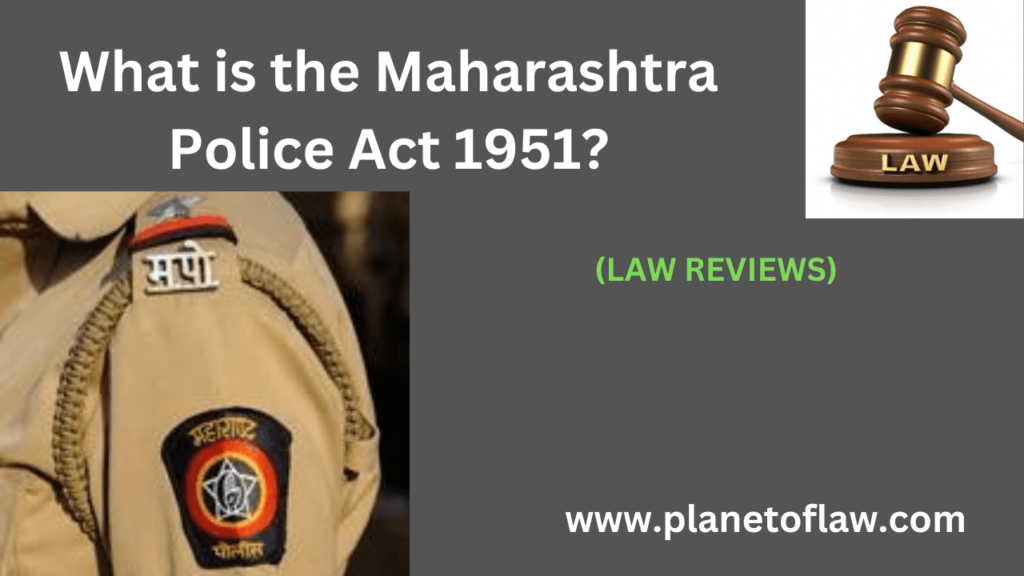Introduction-
The Maharashtra Police Act, 1951, stands as a foundational legislative framework governing law enforcement and public safety within the state of Maharashtra, India. Enacted to establish a robust structure for policing, the Act outlines the organizational setup, powers, functions, and responsibilities of the Maharashtra Police Force. Its enactment aimed to streamline law enforcement activities, promote public order, and ensure the safety and security of citizens across the state.
With its inception, the Maharashtra Police Act, 1951, set forth a comprehensive set of guidelines and regulations to govern the conduct of police officers, the handling of criminal matters, and the maintenance of public order. It provides a legal framework within which the police force operates, facilitating the prevention, detection, and investigation of crimes, as well as the enforcement of laws and regulations.
Throughout its history, the Maharashtra Police Act, 1951, has undergone amendments and revisions to address emerging challenges, adapt to changing societal needs, and incorporate advancements in policing practices and technologies. This dynamic nature reflects its ongoing relevance in shaping law enforcement efforts and ensuring the effective functioning of the police force in modern times.
In essence, the Maharashtra Police Act, 1951, serves as the cornerstone of policing in Maharashtra, guiding the efforts of law enforcement agencies in upholding justice, maintaining order, and safeguarding the rights and welfare of the people. Its provisions remain vital in shaping the course of law enforcement activities and promoting the principles of accountability, transparency, and professionalism within the police force.
What is the Maharashtra Police Act 1951?
The Maharashtra Police Act, 1951, is a legislation that governs the organization, structure, powers, functions, and duties of the police force in the state of Maharashtra, India. It serves as a comprehensive legal framework for the functioning of the police department and outlines the roles and responsibilities of police officers in maintaining law and order, preventing and detecting crimes, and protecting the rights and interests of the public.
Key features and provisions of the Maharashtra Police Act, 1951, include:
- Establishment of the Police Force: The Act provides for the establishment of the Maharashtra Police Force, comprising various ranks and categories of police officers, including constables, sub-inspectors, inspectors, and superintendents.
- Organizational Structure: It defines the organizational structure of the police department, including the hierarchy of ranks, division of responsibilities, and coordination mechanisms within the force.
- Powers and Duties: The Act delineates the powers and duties of police officers in maintaining public order, preventing and investigating crimes, enforcing laws, and protecting life and property.
- Regulations and Procedures: It lays down regulations and procedures governing the conduct of police officers, including rules related to arrests, searches, seizures, interrogations, detention, and evidence collection.
- Special Provisions: The Act contains special provisions for the maintenance of public order during emergencies, festivals, or other events requiring heightened security measures.
- Police Welfare: It addresses matters related to police welfare, including recruitment, training, discipline, promotions, transfers, and retirement benefits for police personnel.
- Accountability and Oversight: The Act establishes mechanisms for oversight and accountability, such as the appointment of Police Complaints Authorities to investigate complaints against police misconduct and ensure adherence to legal standards.
- Legal Framework: It provides a legal framework for the effective functioning of the police force, ensuring compliance with constitutional principles, human rights standards, and due process of law.
Overall, the Maharashtra Police Act, 1951, plays a crucial role in shaping the organization, operations, and conduct of the police force in Maharashtra, guiding their efforts to maintain law and order, uphold justice, and protect the rights and interests of the public.
What is the objectives of Maharashtra Police Act 1951?
The Maharashtra Police Act, 1951, outlines several objectives aimed at ensuring the effective functioning of the police force and maintaining law and order in the state. Some of the key objectives of the Maharashtra Police Act, 1951, include:
- Maintenance of Law and Order: The Act aims to empower the police force to maintain law and order, prevent crime, and ensure public safety and security within the state of Maharashtra.
- Prevention and Detection of Crime: It seeks to provide the police with the necessary authority and tools to prevent and detect criminal activities, investigate offenses, apprehend offenders, and bring them to justice.
- Protection of Life and Property: The Act is designed to safeguard the lives, property, and rights of individuals residing in Maharashtra by deploying police resources effectively and responding promptly to incidents of crime, violence, or emergencies.
- Promotion of Public Safety and Welfare: It endeavors to promote public safety, welfare, and harmony by enforcing laws, regulations, and measures aimed at preventing antisocial behavior, maintaining order in public spaces, and resolving disputes peacefully.
- Upgradation of Police Services: The Act emphasizes the need for continuous improvement and modernization of police services, including recruitment, training, equipment, and technology, to enhance the effectiveness, efficiency, and professionalism of the police force.
- Protection of Civil Liberties: It underscores the importance of protecting civil liberties, human rights, and fundamental freedoms while carrying out police duties, ensuring that law enforcement activities are conducted with due regard for legal and ethical principles.
- Community Engagement and Collaboration: The Act encourages collaboration and partnership between the police and the community, fostering trust, cooperation, and communication to address local concerns, prevent crime, and promote a sense of shared responsibility for public safety.
- Accountability and Transparency: It establishes mechanisms for ensuring accountability and transparency in police operations, including the oversight of police conduct, handling of complaints, and adherence to legal standards and procedures.
Overall, the objectives of the Maharashtra Police Act, 1951, revolve around the fundamental principles of maintaining law and order, protecting public safety and welfare, upholding civil liberties, and promoting professionalism, accountability, and community engagement within the police force.

